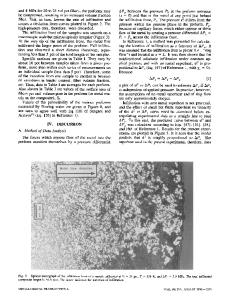Infiltration of fiber preforms by a binary
- PDF / 3,582,695 Bytes
- 18 Pages / 597 x 774 pts Page_size
- 43 Downloads / 443 Views
I.
INTRODUCTION
IN a previous article]~l (hereafter "Part I"), a theoretical analysis of fluid flow and heat and mass transfer was given for infiltration of a fiber preform by a binary hypoeutectic alloy. It was shown that solid metal may form in the composite during infiltration as a result of chilling by fibers initially below the metal liquidus temperature. This results in the formation of up to five regions in the fiber preform during infiltration. These were defined as region 1, with a matrix of primary solid and liquid metal, regions 2 and 3, respectively, with a fully solid and fully liquid matrix, region 4, the uninfiltrated portion of the fiber preform, and region 5, with a liquid and solid matrix of eutectic composition. These regions are indicated schematically in Figure 1 of Reference 1 with their respective locations: along a line leading from the gate toward the uninfiltrated portion of the preform, one encounters regions 3, 1, 5, and 4 in that order. Region 2 is caused by heat transfer to the mold walls and lies in their vicinity. In Part I, t~l a solution was given for adiabatic unidirectional infiltration under constant applied pressure, yielding the distribution of temperature T, fraction solid metal gs, and average matrix composition C along the composite for each set of processing parameters: initial fiber temperature TI, initial metal temperature To, applied pressure APt, and fiber volume fraction VI (a glossary of terms used in this article is given in Appendix B). It was shown that unidirectional adiabatic infiltration driven by constant applied pressure APt can be analyzed using VERONIQUE J. MICHAUD, Postdoctoral Research Associate, and ANDREAS MORTENSEN, Associate Professor, are with the Department of Materials Science and Engineering, Massachusetts Institute of Technology, Cambridge, MA 02139. Manuscript submitted July 22, 1991. METALLURGICAL TRANSACTIONS A
the Boltzmann transformation, which combines time t and position x into a single parameter X = x A b ~ t, where ~b is a constant, quantifying the kinetics of infiltration and defined such that the total infiltrated composite length at time t is L = ~ V't. The system A1-4.5 wt pct Cu/24 vol pct 8-alumina fiber was used as a practical example for numerical results. It was shown that for TI below the matrix liquidus temperature, significant macrosegregation is expected along the length of the composite. This macrosegregation results from solute rejection by the growing primary solid metal, which forms gradually in region 1 with an increasing local temperature. In the present article, we complete the analysis in Part I tl] by proposing a simple model for the permeability of preforms in the presence of the primary solid alloy and deducing the final composite microstructure from the analysis. We also examine the effect of external cooling on the composite macrostructure. We then present resuits from experiments on infiltration of SAFFIL* alu*SAFFIL is a trademark of IC1 Americas, Inc., Wilmington, DE.
mina preforms by A1-4.5 wt pct Cu to
Data Loading...










